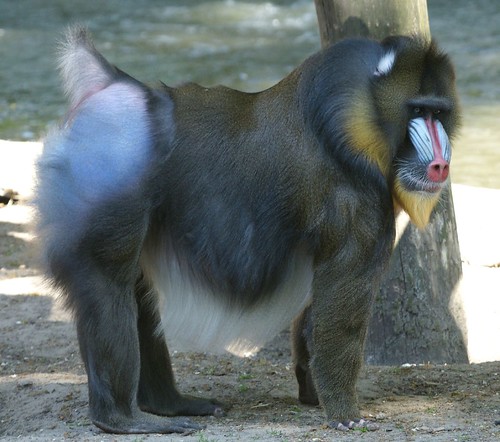Post by dinosauria101 on Feb 26, 2019 2:20:35 GMT 5
Mandrill - Mandrillus sphinx
The mandrill (Mandrillus sphinx) is a primate of the Old World monkey (Cercopithecidae) family, closely related to the baboons and even more closely to the drill. It is found in southern Cameroon, Gabon, Equatorial Guinea, and Congo. Mandrills mostly live in tropical rainforests and forest-savanna mosaics. They live in groups called "hordes". Mandrills have an omnivorous diet consisting mostly of fruits and insects. Their mating season takes place from June to October. Males average 25–35 kg (55-77 lb); females are less than half that weight (11–14 kg, or 25-30 lb). Unusually large males can weigh 50 kg (110 lb). The average male is 81–90 cm (32–36 in) and the female is 56–66 cm (22–26 in), with the tail adding another 5–8 cm (2–3 in). They can survive up to 31 years in captivity. Females reach sexual maturity at about 3.5 years. The mandrill has one of the greatest sexual dimorphisms among the primates.

African Wild Dog (pack of 3) - Lycaon pictus
Lycaon pictus is a large canid found only in Africa, especially in savannas and lightly wooded areas. It is variously called the African wild dog, African hunting dog, Cape hunting dog, painted dog, painted wolf, painted hunting dog, spotted dog, or ornate wolf. he scientific name "Lycaon pictus" is derived from the Greek for "wolf" and the Latin for "painted". It is the only canid species to lack dewclaws on the forelimbs. The African wild dog is the bulkiest and most solidly built of African canids. The species stands 60–75 cm (24–30 in) in shoulder height, and weighs 20–25 kg (44–55 lb) in East Africa and up to 30 kg (66 lb) in southern Africa. A tall, lean animal, with a head and body length of 75–141 cm (30–56 in) plus a tail of 30 to 45 cm (12 to 18 in). Animals in southern Africa are generally larger than those in eastern or western Africa. There is little sexual dimorphism, though judging by skeletal dimensions, males are usually 3-7% larger. The African wild dog's main prey varies among populations but always centers around medium-to-large sized ungulates, such as the impala, Thomson's Gazelle, Springbok, kudu, reedbuck, and wildebeest calves. The most frequent single prey species depends upon season and local availability. For example, in the Serengeti in the 1970s wildebeest (mostly calves) were the most frequently taken species (57%) from January to June, but Thompsons gazelle were the most frequently taken (79%) during the rest of the year.

Credit to Wikipedia
The mandrill (Mandrillus sphinx) is a primate of the Old World monkey (Cercopithecidae) family, closely related to the baboons and even more closely to the drill. It is found in southern Cameroon, Gabon, Equatorial Guinea, and Congo. Mandrills mostly live in tropical rainforests and forest-savanna mosaics. They live in groups called "hordes". Mandrills have an omnivorous diet consisting mostly of fruits and insects. Their mating season takes place from June to October. Males average 25–35 kg (55-77 lb); females are less than half that weight (11–14 kg, or 25-30 lb). Unusually large males can weigh 50 kg (110 lb). The average male is 81–90 cm (32–36 in) and the female is 56–66 cm (22–26 in), with the tail adding another 5–8 cm (2–3 in). They can survive up to 31 years in captivity. Females reach sexual maturity at about 3.5 years. The mandrill has one of the greatest sexual dimorphisms among the primates.

African Wild Dog (pack of 3) - Lycaon pictus
Lycaon pictus is a large canid found only in Africa, especially in savannas and lightly wooded areas. It is variously called the African wild dog, African hunting dog, Cape hunting dog, painted dog, painted wolf, painted hunting dog, spotted dog, or ornate wolf. he scientific name "Lycaon pictus" is derived from the Greek for "wolf" and the Latin for "painted". It is the only canid species to lack dewclaws on the forelimbs. The African wild dog is the bulkiest and most solidly built of African canids. The species stands 60–75 cm (24–30 in) in shoulder height, and weighs 20–25 kg (44–55 lb) in East Africa and up to 30 kg (66 lb) in southern Africa. A tall, lean animal, with a head and body length of 75–141 cm (30–56 in) plus a tail of 30 to 45 cm (12 to 18 in). Animals in southern Africa are generally larger than those in eastern or western Africa. There is little sexual dimorphism, though judging by skeletal dimensions, males are usually 3-7% larger. The African wild dog's main prey varies among populations but always centers around medium-to-large sized ungulates, such as the impala, Thomson's Gazelle, Springbok, kudu, reedbuck, and wildebeest calves. The most frequent single prey species depends upon season and local availability. For example, in the Serengeti in the 1970s wildebeest (mostly calves) were the most frequently taken species (57%) from January to June, but Thompsons gazelle were the most frequently taken (79%) during the rest of the year.

Credit to Wikipedia


